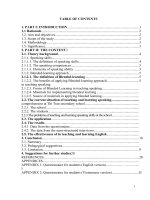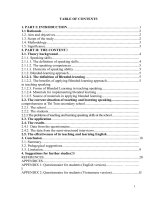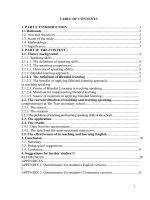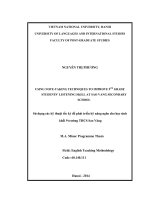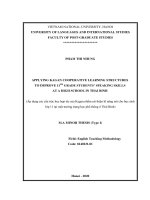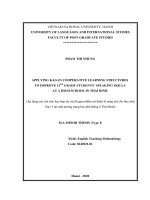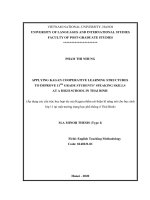(Sáng kiến kinh nghiệm) USING BLENDED LEARNING APPROACH TO ENHANCE 9TH GRADE STUDENTS, SPEAKING SKILLS AT THI TRAN SECONDARY SCHOOL
Bạn đang xem bản rút gọn của tài liệu. Xem và tải ngay bản đầy đủ của tài liệu tại đây (536.3 KB, 18 trang )
TABLE OF CONTENTS
1. PART I: INTRODUCTION.................................................................................1
1.1 Rationale...............................................................................................................2
1.2. Aim and objectives...............................................................................................2
1.3. Scope of the study................................................................................................2
1.4. Methodology.........................................................................................................3
1.5. Significance..........................................................................................................3
2. PART II: THE CONTENT3
2.1. Theory background............................................................................................4
2.1.1. Speaking skills...................................................................................................
2.1.1.1. The definition of speaking skills....................................................................4
2.1.1.2. The speaking competences.............................................................................5
2.1.1.3. Elements of speaking ability..........................................................................5
2.1.2. Blended-learning approach................................................................................5
2.1.2.1. The definition of Blended-learning.............................................................5
2.1.2.2. The benefits of applying Blended-learning approach.....................................5
in teaching speaking
2.1.2.3. Forms of Blended Learning in teaching speaking..........................................
2.1.2.4. Materials for implementing blended learning ...............................................
2.1.2.5. Source of materials in applying blended learning..........................................
2.2. The current situation of teaching and learning speaking...............................
comprehension at Thi Tran secondary school.............................................................
2.2.1. The school.........................................................................................................
2.2.2. The students.......................................................................................................
2.2.3.The problems of teaching and learning speaking skills at the school...............................
2.3. The application...................................................................................................
2.4. The results...........................................................................................................
2.4.1 Data from the questionnaire..............................................................................
2.4.2. The data from the semi-structured interviews...................................................
2.5. The effectiveness of in teaching and learning English....................................
3. Conclusion..............................................................................................................18
3.1. Summary...............................................................................................................
3.2. Pedagogical suggestions.......................................................................................
3.3. Limitation.............................................................................................................9
4. Suggestions for further studies20
REFERENCES............................................................................................................20
APPENDICES.............................................................................................................
APPENDIX 1: Questionnaire for students (English version)................... ...............
I
APPENDIX 2: Questionnaire for students (Vietnamese version)...............................II
1
1. PART I. INTRODUCTION
1.1. Rationale .
In Vietnam, English has been taught as an important foreign language for a
long time but due to grammar-translation method of teaching, Vietnamese
students seem to be better at grammar than communicative competence.
Therefore, according to a large project to investigate the English teaching reform
in northern parts of Vietnam, only 5% of students are able to communicate in
English after graduation (Hoang et all, 2005). This fact gives rises to the need
for nationwide innovation in the teaching methodology in the light of
communicative approach.
Blended learning is one of the recent ways which combines a face-to-face
classroom component with an appropriate use of technology. The term
technologycovers a wide range of recent aspects, such as the internet, CD–Roms
and interactivewhite broad. It also includes the use of computers as a means of
communication,such as chat and email, and a number of environments which
enable teachers toenrich their courses. Blended learning is very useful for
students in learning English because thatenables them to practice language
inside and outside the class room, which enhancestheir ability in the language
skills, particularly speaking skills, (Pete and Barney2009, p40).
Interactive materials on web and CD–Roms offer opportunities to
developlanguage skills, such as reading, writing, speaking and pronunciation.All
the aforementioned conditions drive the author to carry out the research “Using
Blended-learning approach to enhance 9th grade students’ speaking skills at Thi
Tran secondary school”. Hopefully, this study will make a small contribution to
improving speaking skills for grade 9th students at Thi Tran secondary school.
1. 2. Aim and objectives
The aim of this study is to explore the exploitation of using Blendedlearning approach to enhance students’ speaking skill. In order to achieve the
aim, the writer focuses on finding out the effectiveness of applying Blendedlearning approach in guiding students how to improve their speakingcapability
and proposing strategies to teach speaking skills using Blended-learning
approach.
1. 3. Scope of the study
Acquiring speaking skill is a vast issue in language learning. However,
due to the limit of time, experiences and knowledge, this study touches upon
only some applications of Blended-learning approaches which are used in
teaching speaking skill and cannot cover all the speaking techniques in teaching
and learning.
1.4. Methodology
The major method which was used in study is qualitative. All comments,
remarks, assumptions and conclusions of the study were based on the data and
analysis. Data collections for analysis in the study were gained through the
2
following resources: survey questionnaire, observations, as well as reference
books. After the data were collected, they were categorized and analyzed
quantitatively and qualitatively to obtain the realistic results.To end with, based
on analysis of survey results and references, some pedagogical implications and
suggestions in order to improve teaching and learning English speakingskill
using Blended-learning approach will be proposed.
1. 5. Significance
This study points out the effectiveness in applying Blended-learning
approach in speaking lessons andIncrease the students’ achievement in English
language as well as improve theirspeaking skills.More importantly, it offers
some suggestions for teachers to enhance students’ English speaking
competence through the use of Blended-learning approach. Hopefully, the
findings and recommendations of this study will be of some help to the
improvement of the teaching and learning speaking skill for Thi Tran secondary
students.
2. PART II: DEVELOPMENT
2. 1. Theory background
2.1.1. Speaking skills
2.1.1.1. The definition of speaking skills
The teacher has found several definitions of speaking as follows:
Channey(1998, p.13) stated that " speaking is the process of building and
sharing meaningthrough the use of verbal and non- verbal symbols in a variety
of contexts" In the other words, speaking is a skill which need the speaker to
interact with others deeply to be perceived and understood, then constructing the
meaning, pronouncing, and being fluent and accurate in using grammar and
vocabulary..
From the above display, the teacher notice the ability to speak aforeign
language involves several components that speaker need to acquire in order
tocommunicate effectively. She also added communicative competence must
includenot only the linguistic form of a language but also knowledge of when, how
and towhom it is appropriate to use this form. However, in Vietnam, as the examoriented ways of teaching in secondary schools and no speaking part is included in
high school entrance examination, English learning generally emphasizes more on
the reading and writing skills than listening and speaking skills.
2.1.1.2. The speaking competences
To carry out a successful speaking task, the following competences should be
acquired:
Initiating a conversation: Knowing how and when to open a conversation
is akey speaking competence that learners must be taught. A study by Mc Cathy
and O'keeffe (2004, p. 5) has shown that much classroom conversation involves
the teacher taking the role of an initiator.
Turn-taking: This is the interaction management skill that learners would
do well to acquire what.Bygate (1998: p.65) and Flucher (2003, p. 24) illustrate
3
that turntaking and adjacent–pair practice will provide learners within
dispensable knowledge of when it is appropriate to listen and talk, for how long,
and the preferred response pattern to adopt.
Verbal and non–verbal symbols: It is the ability to convey meaning by
encompassing appropriate expressions verbal and non–verbal in the proper
context. Channey (1998, p. 13) assures that speaking through the use of verbal
and non- verbal symbols in a variety of contexts.
Participation, interaction and engagement: To create English Language
Classroom that is full of fun and a dynamic place to be, right activities should be
taught in the right way. Speaking in the class can be a lot fun, raising general
motivation. Consequently, Sari (2011, p. 2) adheres to the idea that if the
students do not learn how to speak in the language classroom, they may soon get
bored and lose interest in learning the foreign language.
It has become increasingly clear that success in school is a product of
learning the language. Interacting through talking at home and in school is
essential in bringing about oral language fluency and ultimately literacy.
2.1.1.3. Elements of speaking ability
Heaton(1988) divided the elements of speaking ability into three parts:
Accuracy: Pronunciation maybe heavily influenced by native language but
should be generally intelligible. No confusing errors of grammar or vocabulary.
Accuracy in speaking means someone can produce correct sentences in
pronunciation, grammar and word choice so can be understood. There are three
components accuracy: pronunciation, Vocabulary, and grammar.According to
Webster Dictionary (2003)pronunciation is the way in which a word is
pronounced, the spelling of words in accordance with their usual pronunciation.
Pronunciation teaching deals with recognition or understanding the flow of
speech and production of words.
Fluency: The speaker may often have to search for a way to say. Contribution
maybe limited to one or two simple utterance. According to Brown 1 (2001)
states that fluency is the ability to use a language spontaneously and confidently
and without undue pauses a hesitation. Fluency is an aspect that influences very
much the students’ ability in speaking English. The teachers have to guide the
students to develop to master it to be fluent in speaking. In this case, the students
can speak spontaneously by using a right language or the students do not use too
many unnatural pauses but succeed in conveying the general meaning and fair
range of expression.
Comprehensibility: Comprehensibility is the process of understanding of
the utterances sent by the speaker done by listener. Clark states that
comprehensibility has two common senses. In its narrow sense, it denotes the
building of meaning from sounds. Comprehensibility in broader sense denotes
the interpretation the meaning and utilizes the speech act conveyed. 2In other
1
2
4
words, if there are two people want to make communication to each other, they
have to be speaking because they have different information. The activity of
speaking or communication should be understood by the speaker and listener.
For example, a question, listener extracts the importation then tries to search the
answer for it.
2.1.2. Blended-learning approach
2.1.2.1. The definition of Blended-learning
Blended learning has been defined as a mixture of traditional learning and
onlinelearning (Williams, 2002; Osguthrope& Graham, 2003). It is also defined
as the integrationof e-learning tools such as virtual learning environment with
face-to-face learning (Welker&Berardino, 2006). Thus, we could say that the
term 'blended learning' refersto everytime teachers mix different media (e.g.
print,audio, and video) with classroom interaction.
In the current study the blended learning refers to a combination of online
andface-to-face methods in response to the learners’ needs and for the
achievement ofinstructional objectives. This means that multiple approaches,
methods and resources toteaching or to educational processes are combined and
utilized by the teacher who nowexpects the students to learn not only from the
assigned web pages and communicationtools (e.g. email, discussion board and
chat rooms) but also from face to face lectures,tutorials, person to person
discussions and seminars.
Figure 1: Blended- learning
2.1.2.2. The benefits of applying Blended-learning approach in teaching
speaking
Research suggests that when online and face-to-faceelements are
combined, learners often place a greater valueor emphasis on the face-to-face
aspects of the experience (Graham, 2004). But teacher–learner communication
does not stop when learners leave the classroom; it continues outside the
classroom environment. And with the right blend, the classroom time can be
used to maximum effect.
Firstly, Blended learning makes education more accessible. With
traditional teaching methods, educational materials were only available during
classroom hours. Students may have been able to take their textbooks home with
5
them, but they didn’t have a way to actually interact with or engage the material.
With new learning apps and other technological advances, they have more
flexibility to access and engage academia from home. This accessibility could
translate to a much greater interest in learning and more successful outcomes
Secondly, Students can pace themselves. Blended learning that uses apps,
games, or measurable programs to teach concepts allows students to engage the
material at their own pace. This helps to balance a classroom that contains both
quick and slow learners. Every student can practice and tackle new material with
timing that is perfect just for them. It can promote deeper learning, reduce stress,
and increase student satisfaction.
Last but not least, Teachers can become more engaged with their students.
Blended learning presents an increased opportunity for students to connect with
their professors and teachers. They can connect via email, through progress
reports on the program, or on message boards. This learning style promotes a
number of effective means for teachers and students to become more engaged
with one another. In the end, both parties can benefit from this shift in the
relationship. Teachers can stay in touch with student progress, while students
can ask more questions and gain deeper knowledge.
2.1.2.3. Forms of Blended learning in teaching speaking
Rotation Model: In this model, students rotate between learning paths or
“modalities”-one of which online learning-either on a fixed schedule or at the
teacher’s discretion. There are several popular sub-classes of the rotation model.
Station Rotation: In this model, students rotate between various stations
within theclassroom, and at least one of these stations includes an online
learning component
Lab Rotation: Students rotate between the classroom environment and the
learning lab, all whilestaying on the school campus.
Flipped Classroom: In the flipped classroom, students rotate on a fixed
schedulebetween classroom instruction during the school day and online outside
of schoolhours.
Individual Rotation: In this rotation model, students customize how they
rotatebetween modalities. Either theteacher-of-record or an algorithm can set
individual student rotation schedules, butonce set, these schedules usually stay
fixed.
Flex Model:Similar to the individual rotation model, the flex model
features students working on a customized schedule that rotates between
modalities, one of which is online learning. Although the teacher-of-record is
on-site and interacts with students face toface, this support is flexible and
adaptive to individual student needs. This blended learningapproach also allows
for creative classroom/school configurations, for example bycombining study
space, breakout rooms, learning labs, small group work rooms, and socialareas.
“A La Carte” Model:The A la carte model-also known as the “selfblend”model-allows students to design their educational experience by selecting
6
specific online courses to supplement their traditional in-school coursework. For
the online coursework component, the teacher-of-record is virtual and learning
occurs either in theschool or off-site.
Enriched-Virtual Model:In this model, students learn primarily online,
butsplit their time between the brick-and-mortar school campus and an off-site
environment. It is a “whole school experience,” which means that it is a
comprehensiveapproach to schooling. The teachers-of-record are primarily
virtual, although teachers or paraprofessionalsprovide supplemental support in
the brick-and-mortar environment as well.
2.1.2.4. Materials for implementing blended learning
Worksheets and other materials: Worksheets and other materials are
available for classroom use, homework orself-study. You can find specific
materials for young learners, and special purposes,exam preparation, skills
work.
Exercises and Tests: Many exercises available online and on CD-ROM
focus on grammar andvocabulary. Such exercises are an ideal way to practise
discrete items such as contrasting two structures (e.g. since and for) or
confusable words. Among the most common activity types are multiple choice.
Vocabulary Reference: Vocabulary input for learners includes specialist
vocabulary for ESP areas thatare well served on the Web. Learners can access
functional language for situationssuch as making telephone calls or giving
presentations.
Language Games: Games are another electronic alternative to books and
paper based exercises.They are principally aimed at younger learners although
there are also games whichcan be used by adults. They focus on topics such as
vocabulary, spelling and grammar.
Speaking and pronunciationinteractive materials on the Web and on
CD-ROM:offer opportunities todevelop language skills like speaking and
pronunciation. Fluency practice is usually organized by the teacher, and is an
area which Learners can read and record alternate lines in a dialogue,and then
play back the complete dialogue. CD-ROMs can also be helpful in the areaof
pronunciation. On some disks, the learner can click on a version of the
phonemicchart and listen to the individual phonemes. Some disks display the
intonation patternthe learner uses in visual format.
2.1.2.5. Source of materials in applying blended learning
Downloadable Materials: In the case of downloadable materials, once you
have saved the files on your computer, your link to the internet can be
disconnected. Material intended to be printed, such as worksheet, or materials
which can be stored and distributed by email, such as (MP3) files, are normally
delivered by this method.
Online Materials: In contrast to downloadable materials, these rely on the
learners having access to a computer connected to the Internet. Online exercises,
7
test, games and listening activities often require little programs that integrate
with your browser.
Material on Disk: Finally, some materials are available in disk format.
ACD-ROM is essentially a stronger device. It can store digital data in formats
such as text, pictures, photographs, animations, video clips and audio clips. CDROMs offer language learners the exciting possibilities of a multimedia
environment, allowing them to move between the various media at will. There
are also DVDs, the main difference being that these offer a lot more storage
space.
2.2.The current situation of teaching and learning speakingskill at Thi Tran
secondary school
2.2.1. The school
This study was conducted at Thi Tran secondary school in ThuongXuan
district, ThanhHoa province. In the school year 2017-2018, the school had 13
classes with more than 400 students, among which there were 112 ninth grade
students divided into four classes, so there were about nearly 30 students in each
class. One thing worth to note here is that the level of students at Thi Tran
secondary school is not very high. They mostly come from rural areas where
English teaching and learning has not been paid much attention to. Besides, the
school shares common features with classrooms elsewhere in Vietnam: large
size, students sitting in rows of four each and irremovable furniture
2.2.2. The students
Students under this investigation are 30 students of class 9A of Thi Tran
secondary school within the second semester from the 1st February to the April
29, 2018. There were 18 girls and 12 boys. They were the same age and had the
same total years of learning English with the same curriculum from primary
school to secondary school. Most of them could do grammar very well but they
have difficulties in speaking skills, especially in one - way speaking situations
where they did not have opportunities to see or interact with speakers of English.
Difficulties are created by the students’ limited knowledge of the
language system and their lack of experience hearing fluent natural speechin
target language and English speaking environment. This is due to the
inappropriate learning strategies in speaking, and the time limitation for teachers
of English in class. Each week, they had three forty - five minute English
lessons and one more selective lesson. Of four skills: reading, writing, speaking
and speaking, they found speaking is the most challenging skill.
2.2.3.The problems of teaching and learning speaking
skills at the school
In secondary schools in Vietnam, the textbooks are designed for all
students of different grades. Among them, this study stresses that using the same
textbooks for all students in different regions is problematic. Especially in the
research school, a remote and mountainous one, English proficiency of most
8
students cannot be as high as those from cities or towns using the same
textbooks.
In the other hand, the failure of students in speaking may also be
originated from the fact that the teaching and learning process of speaking is not
conducted effectively and the inappropriate teaching method is applied by the
teacher. In other words, the students may find the strategies which the teachers
use not interesting and effective enough to develop their speakingskill.
2.3. Application
In planning, the teacher prepared syllabus, lesson plan, source of online
learning, blended learning strategy based on the English 9 curriculum of the
Vietnamese ministry of education and training. To reach the stated goal, the
action plan is executed during the second semester. The project comprises two
phases (12 weeks, second semester 2017-2018).
The former, In-class activity which consists of selected awareness-raising
activities and essential speaking-strategies training activities, is to raise students’
awareness of the problem as well as equip them with necessary skills to make
use of online materials and acquire more confidence in speaking skill and then
designed in-class activities for target language of each unit.
The latter toughens such awareness and strategies in learners by
involving them in the speaking practice. This stage is of great importance since
only raising student’s awareness cannot ensure the raise in the autonomy level.
Once they are armed with necessary skills and appropriate knowledge, they are
asked to choose from various types of autonomy-fostering activities and commit
to do the activities regularly. The activities require the students to prepare at
home and report their results in the next lesson.
Teachers ought to provide thenecessary resources to adjust these
instructions to fit students’learning needs and see how students make use of this
toolto learn. Therefore, the creation and adaptation of materials are expected to
aid the learners’self-investment and different speaking strategies such us:
representing sounds in memory,recalling vocabulary, discussing your feelings
with someone else and developing culturalunderstanding, within the classroom.
Phase 1
In the first step, teacher embraces on-lesson-basis information-sharing and
reporting tasks to encourage reflection of the use of coping strategies. These
activities help them to enrich the essential vocabulary, widen their knowledge
and especially create more chances to practice speaking skill. In an effort to
keep students from putting off all work to the last moment, it is beneficial to
stipulate that some product must be handed in and report in class.
In-class activity: At the beginning of each lesson, students have 15
minutes’ information exchanging. Now that they are at an advantage of being
prepared for class, they have to hand in their assignment during the informationsharing task. Students exchange pairs to share the information that they have
achieved without reference to the article but the summary. The assignments will
9
be given back to students the following lesson. During their activity, one student
tells the news, and the other must take notes. They are encouraged to ask
questions and use any appropriate techniques to maintain the conversation and
comprehend the information given to take notes. These notes must be hand
posterior. This note taking is to certify that they try to perceive the information
from their partners, acquire equal participation, and set room for the use of
compensatory techniques. Furthermore, the use of these techniques is fostered
by applying no-Vietnamese rule.
Phase 2
In this step students make use of online materials to practice after school
Out-class activity: students take at least thirty minutes a day to revise the
knowledge they have learnt in the classroom with the implementing online tool
on two websites : sachmem.com and tienganh123.com. In the next lesson at
school, they spend about ten minutes for pair work activity, the next five
minutes is reserved for some pair presentations in front of the class. In the
consecutive three meetings, they use ten minutes for pair work activity and the
next five minutes for individual report in front of the class. One or two students
make presentations in front of the class, reporting the news that they have just
received. In doing so, students will feel more secured, and gradually become
accustomed to public presentations. Holding the rehearsal, they will be more
willing to speak up. The final product is a record of all assignments and notes
attained during the project. Besides, the assessment is also based on students’
active participation in class, especially while doing the activities.
By this students do great efforts in using all the materials and the speaking
techniques to communicate with their partners in the target language. The
gradual individual presentation merging helps them to gain fearlessness in
speaking. Hereby, they can implant not only self-directed leaning attitudes but
also take appropriate psychology in the learning process. Concurrently, their
speaking skill is upgraded. However, depend on different activities, teacher
should give appropriate tasks for students in face to face lesson as well as online
lesson. The following are examples that I have used:
Example :UNIT 7- GETTING STARTED (page 7-8) SGK English 9
Phase 1: In-class activity
- After asking students about their favourite dishes. Elicit answers from
students and quickly write them on the board. Teacher introduce the new words
on the board by different techniques
10
Figure 2: Teaching New Words
- The pronunciation of all the target words and model sentences should be
demonstrated by the native speakers (In this theme of the project, teacher can
download from sachmem.com or tienganh123.com). In this stage, teacher plays
the role of facilitator who helps students to pronounce correctly the new words
as perfect as possible comparing with the pronunciation in the tape or on web.
These activities help them to enrich the essential vocabulary, widen their
knowledge and especially create more chances to practice speaking skill. In an
effort to keep students from putting off all work to the last moment, it is
beneficial to stipulate that some product must be handed in and report in class.
Figure 3: Teaching New Words
- With the rest part of the lesson, it is important for the teacher to have
students read the questions to make sure they understand them. Ask them firstly
to answer the questions without reading the dialogue again.If there is some time
left, have students work in their groups and write down a similar quiz. Set a time
limit of about five minutes. Continue the activity until all the groups have read
out all of their questions or when time is up.
Phase 2: Out- class activities
In this stage,students must be well equipped with adequate awareness of
the learning process, learning strategies as well as given more empowerment
in their study without assistance starvation from the teacher. On
11
sachmem.com, firstly students should review all the new words of this part with
the aid of the websites.
/>
Figure 4: Revise Vocabulary at home
- Next, students have to spend at least 15 minutes for listening this part
three times a week and try to model the sentences in the dialogue. They can
replay as many times as possible and repeat the target dialogue. The color
will turn yellow when the speech is pronounced.By this, students have a
chance to develop not only speaking but other skills are involved. Listening
skills allow the person to understand what other person speaks. Speaking skills
helps to convey the same what he listened in the right manner. Reading skills is
essential to interpret what is in the text. Writing skills is used to express their
own thoughts. After two weeks, the students gradually feel interest in learning
and try to listen, record, write and practice at home
12
Figure 5: Practice The Text Online
- Finally, students record the target text and send to the teacher through
email or other social means like: Hangout; Skype…Feedback will be
delivered by the teacher individually or in front of the class so that the
students can learn from each other.
- During this study, students were actively receiving feedback from their
classmates and teacher, as well as providing feedback to their partners during
the face-to-face sessions after the virtual lessons were implemented; this
definitely was effective for them. Hence, students mention that blended learning
allowed them to make errors and to make them up.
The examples above evidence how blended learning was used to helped
students improve their speaking skill and, thisstep will foster students to
motivate to create dialogue in part Communication. The process of learning and
practicing the Getting started will facilitate students to complete the speaking
tasks in the Communication part of each unit.
13
Figure 6: Post-speaking (Communication- page 13)
The teacher always reviewed the students’ performance and learning
material in the end of the class. The lecturer reviewed the students’ performance
at the face to face class, in this case the lecturer gave feedback to the students
about their problem during theteaching-learning process. Learning material must
also bereviewed by the lecturer,that the lecturer could provide the appropriate
material for the students.
From the reflection of the students, it was known that the weaknesses
were the students were not yet familiar to all online learning source informed in
the group and in the class, the students less practiced because some students still
asked on how to maximize online source for their self-learning. It happened
because the teacher did not explain every single link clearly while informing in
the group. While interviewing several students, they said that they felt more fun
by Blended Learning model but they need to be accustomed.
2. 4. The results
The implementation of Blended Learning in class 9A at Thi Tran
secondary school to improve speaking skill was done in three months. The
teacher combined online learning and traditional face to face learning. The
online learning source was announced in whatsup group before face to face
meeting. The online learning sources are websites tienganh123.com and
sachmem.vn. It is proven that Blended learning can solve the students’ problem
in the class like inadequate learning and practicing time, afraid of making
mistakes, being shy and unconfident to practice, by seeing their average score in
every period of time they had been through.
2.4.1.Data from the questionnaire
14
After finding a significant increase in learning for the experimental group,
students received a questionnaire to determine the reasons for their enhanced
learning. In the questionnaire, the subjects were asked about their perception of
e-learning’s effect on their language skills.
QUESTIONS
MEANS SD
The blended learning helps the students understand the
4.50
0.51
1
subject better.
2
The lessons in blended learning program are
interesting.
4.40
0.56
3
The teacher should use this program to supplement inclass teaching.
4.57
0.50
4
Blended learning motivates the students to study by
themselves.
4.65
0.55
5
The students’ learning experience is enhanced by t
Blended learning
4.43
0.50
6
Blended learning
language skills.
4.53
0.51
7
Blended learning develops students speaking skills.
3.80
0.41
program
develops
students’
Table 1: Questionnaire
As can be seen from Table 1, the students in the experimental group had
favorable attitudes towards enhancing their language skills through blended
learning. Most students thought that this program should be a supplement to inclass teaching. In addition, there was a favorable response relating to
motivational aspect delivered through the use of technology. It motivated the
students to study by themselves. It also helped them better understand the lesson
because the supplementary lessons covered similar content. Moreover, students
felt that this program could both facilitate and enhance their learning experience.
2.4.2. The data from the interviews
The students’ responses for interest and experience in blended learning
are as follows.
First, the participants responded positively for interest in using blended
learning in English speaking classes. 87.1% of the participants showed interest
(very interested, 25.8% and fairly interested, 61.3%), 12.9% were not
particularly interested, none responded to be not interested. The results show
that students’ interest in blended learning in English classes is very high.
Thestudents seem to consider blended learning is an innovative and effective
15
way to study English, which seemed to be the cause of their highly positive
responses.
Second, the students’ experiences in blended learning were investigated.
In this study, blended learning is used to provide the online environment in
blended learning where interaction between learner(s) and learner(s), learner(s)
and teacher, and among learner(s), teacher, and multimedia take place. The
participants for this study responded negatively regarding prior experience in
blended learning classes. 46.8 % of the participants have been in blended
learning classes before whereas 53.2% have not experienced blended learning in
prior to the current study. Participants who have experienced blended learning
seemed to be mostly upper classmen who had more exposure to variety of
university courses than freshmen and sophomores.
The downside is that of time constraints caused by the computers/network
being down or very busy. These technical difficulties may be dealt with through
upgrading and maintaining of technical equipmentserver, intranet and the
Internet. In the event that additional spending on system upgrades is unrealistic
or impossible, a self-defined blended learning environment can be established
within the situational constraints.
2.5 The effectiveness of implementing blended-learning approach in
learning and teaching English
Based on the information from the findings, the teacher found that the use
of Blended-learning approach bring both students and teacher many benefits
both teachers and learners perceive that e-learning can help students take
responsibility for their own learning by making them autonomous and confident.
This enables introverted students to interact more freely, provides diversification
of activities, fosters an intrinsic impetus of learning and permits the acquisition
of valuable study and time management skills.
Moreover, Blended-learning also allows teachers to have a more studentcentered form of learning. Teachers can use Blended-learning to develop EFL
students’ language skills and activate their independent learning. The findings
revealed that Blended-learning is an essential approach that should be used to
supplement the EFL face-to-face classroom lessons. It is seen to enhance the
students’ language proficiency and promote independent learning.
3. PART III: CONCLUSION
3.1. Summary
This study aims at investigating the exploitation of Blended-learning
approach on enhancing students’ speaking skill. The study was conducted over
thirty 9th grade students and two teachers of English at Thi Tran secondary
school.
From the findings, it appears that students have positive perceptions
toward the benefits of the applying blended-learning approach in speaking
lessons. Their progress in speaking ability was evaluated by the comparison
between before and after English speaking tests. With the meaningful
16
improvements in outcomes above, it can be concluded that using Blendedlearning approach in speaking lessons benefit students in many ways such as
concentrating on speaking process, remembering information, review and recall
the information easily, which led to two times higher scores in the speaking test
after four months.
Based on the findings, some suggestions for applying online materials
with traditional face to face class in teaching and learning speaking will be given
for a better speaking lesson with the use of Blended-learning approach.
3.2. Pedagogical suggestions
Blended learning is a valuable concept that can be used to more
successfully achieve teaching goals. It allows students to develop and practice
English language skills outside the classroom at anytime and anyplace they
choose, as long as they have access to an Internet connection. In addition, it
permits them to repeat lessons without judgment or pressure. The proven
enhancement of student learning documented in this study validates this type of
Blended-learning.
The addition of online-learning to classroom teaching provides students
with opportunities for autonomous learning and a decentralized transfer of
knowledge. Blended learning is an approach which takes into account different
learning styles and combines different learning environments in a flexible,
integrated and complementary way in order to help, support and enhance
learners' diverse needs and provide a successful, efficient and enjoyable learning
experience
Mixing different media, different modes of delivery and different instructional
strategies is not a new approach, but the capabilities of today's technology can
make a blended approach both easier and more meaningful for learners. Blended
learning puts learners at the centre of the learning process, encouraging them to
be more independent, and also helps teachers in their vital role of supporting
learning.
Blended learning, appropriately conceived, developed and delivered , can
support any number of learners, anywhere and anytime; it can help managers
use human and other resources in the most efficient way possible to give
learners the best learning experience possible. It is satisfying to know that there
is a growing body of evidence to support the view that blended learning can
result in a better student learning experience, an improvement in learning
outcomes, and greater student motivation, confidence and satisfaction, leading to
learners becoming more independent learners and enjoying learning the
language.
3.3. Limitation of the research
Although the study was conducted with the best of my effort, it still has
some limitations such as number of participants of the study is limited. Thus,
findings of the study cannot generalize to all the students of the school. In
addition, due to lack of time and limitation of knowledge, the author has not
17
considered all aspects of the issue, and mistakes of the study are unavoidable.
The author would like to receive comments from the other teachers and those
who concern this issue for further studies with sincere gratitude.
4. Suggestion for further studies
This study is only investigating the application of note-taking Blended
learning in teaching and learning speaking skill. Further studies should be
devoted to evaluate the application of Blended learning strategies on teaching
and learning other skills like reading, speaking or writing.
REFERENCES
1. Dawley, L. (2007) The tools for successful online teaching, London:
Information Science Publishing.
2. Dornyei, Z. (2001) Teaching and researching motivation, Harlow: Longman.
3. Aug 2014] H. D. (2007). Teaching by principles: An interactive approach to
language pedagogy. Third edition. White Plains, NewYork: Pearson
Education.
4. Graham, C. R. (2006) Blended learning systems: definition, current trends,
and future directions, C. J. Bonk and
5. C. R. Graham, The handbook of blended learning: Global perspectives, San
Francisco, CA: Pfeiffer Publishing.
6. Key, M. R. (1981) The relationship of verbal and nonverbal communication.
XÁC NHẬN
CỦA THỦ TRƯỞNG ĐƠN VỊ
Thường Xuân, ngày tháng năm 2019
Tôi xin cam đoan đây là SKKN của mình viết,
khơng sao chép nội dung của người khác.
(Ký và ghi rõ họ tên)
Nguyễn Thị Phương
18
